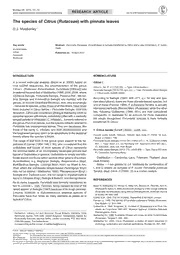
The species of Citrus (Rutaceae) with pinnate leaves PDF
Preview The species of Citrus (Rutaceae) with pinnate leaves
Blumea 55, 2010: 73–74 RESEARCH ARTICLE www.ingentaconnect.com/content/nhn/blumea doi:10.3767/000651910X499222 The species of Citrus (Rutaceae) with pinnate leaves D.J. Mabberley1 Key words Abstract Feroniella (Rutaceae: Aurantiodeae) is formally transferred to Citrus and a new combination, C. lucida, made. Aurantioideae Citrus Published on 16 April 2010 Feroniella Rutaceae INTRODUCTION NOMENCLATURE In a recent molecular analysis (Bayer et al. 2009), based on Citrus L. nine cpDNA sequences, the circumscription of the genus Citrus L., Sp. Pl. 2 (1753) 782. — Type: Citrus medica L. Citrus L. (Rutaceae: Aurantioideae, Aurantieae [Citreae]) was Feroniella Swingle (1913) 776, syn. nov. — Type: Feroniella oblata Swingle broadened beyond that of Mabberley (1998, 2004, 2008, where = Citrus lucida (Scheff.) Mabb. Clymenia Swingle, Fortunella Swingle, Poncirus Raf., Microc- According to Swingle (1943: 468–471, q.v. for key and spe- itrus Swingle and Eremocitrus Swingle are reunited with the cies descriptions), there are three pinnate-leaved species, but genus), to include Oxanthera Montrouz. and, very surprisingly one of these (Forman 1958), F. pubescens Tanaka, is actually – because its species, unlike those of all the others, have never Harrisonia perforata (Blanco) Merr. (Rutaceae), while the other been included in Citrus before – Feroniella Swingle. Until this two, following Guillaumin (1946: 651), are now considered revelation, Citrus was considered (Zhang & Mabberley 2008) to conspecific. In readiness for an account for Flora malesiana comprise species with simple, unifoliolate (often with a markedly the single recognised ‘Feroniella’ species is here formally winged petiole) or trifoliolate (C. trifoliata L., formerly referred to transferred to Citrus: the genus Poncirus) leaves, but the species hitherto referred to Feroniella has imparipinnate leaves. They are deciduous, like those of the hardy C. trifoliata, and both deciduousness and 1. Citrus lucida (Scheff.) Mabb., comb. nov. the toughened pericarp seem to be adaptations to the seasonal Feronia lucida Scheff., Natuurk. Tijdschr. Ned.-Indië 31 (1870) 19; Icon. forests where the species is found. Bogor. 2 (1904) t. 149. The range of leaf form in the genus gives support to the hy- Ferioniella lucida Swingle (1913) 781; (1943) 470, t. 74; Guillaumin (1946) pothesis of Corner (1964: 146, t. 50), who considered that the 651. — Type: Anon. s.n. (ex Rembang coll. Teijsmann) (holo BO; iso L, unifoliolate leaf typical of most species of Citrus represents U), Indonesia, Java, cult. Hort. Bogor. Feroniella oblata Swingle (1913) 779; (1943) 469. — Type: Pierre 652 (holo the terminal leaflet of an incompletely developed pinnate leaf P), Cambodia, Samroing-Aong. typical of Sapindales in general. Unifoliolate or simple and trifo- liolate leaves are found within several other genera of subfam. Distribution — Cambodia, Laos, ?Vietnam, Thailand, Java Aurantioideae, e.g. Aeglopsis Swingle, Balsamocitrus Stapf, (teak forests) Burkillanthus Swingle, Luvunga Buch.-Ham. ex Wight & Arn. Notes — I am grateful to J-F Veldkamp for confirmation of (from which the unifoliolate/simple-leaved Paramignya Wight L and U sheets as isotypes of F. lucida. Feroniella puberula may not be distinct – Mabberley 1998), Pleiospermium (Engl.) Tanaka, Stud. Citrol. 2 (1928) 23 is a nomen nudum. Swingle and Triphasia Lour.; the full range to impari pinnate is found in Citropsis (Engl.) Swingle & Kellerm. and Naringi Adans. REFERENCES As its name suggests, Feroniella was formerly considered al- lied to Limonia L. (syn. Feronia), being classed as one of the Bayer R, Mabberley DJ, Morton C, Miller CH, Sharma IK, Pfeil BE, Rich S, ‘wood apples’ of Swingle (1943) because of its tough pericarp. Hitchcock R, Sykes S. 2009. A molecular phylogeny of the orange subfamily Limonia, however, is diplostemonous whereas species of (Rutaceae: Aurantioideae) using nine cpDNA sequences. American Journal of Botany 96: 668–685. Feroniella have four times as many stamens as petals as is Corner EJH. 1964. The life of plants. Weidenfeld & Nicolson, London. typical of Citrus. Forman LL. 1958. The identity of Feroniella pubescens Tanaka (Rutaceae). Kew Bulletin 12: 503–504. Guillaumin A. 1946. Rutaceés. In: Humbert H, Supplément à la Flore Gé- nérale de l’Indochine: 593–657. Muséum National d’Histoire Naturelle 1 Herbarium, Library, Art and Archives, Royal Botanic Gardens, Kew, Phanérogamie, Paris. Richmond, Surrey TW9 3AB, United Kingdom; Netherlands Centre for Mabberley DJ. 1998. Australian Citreae with notes on other Aurantioideae Biodiversity Naturalis (section NHN), Leiden University, P.O. Box 9514, (Rutaceae). Telopea 7: 333–344. 2300 RA Leiden, The Netherlands; Mabberley DJ. 2004. Citrus (Rutaceae): a review of recent advances in corresponding author e-mail: [email protected]. etymology, systematics and medical applications. Blumea 49: 481–498. © 2010 Nationaal Herbarium Nederland You are free to share - to copy, distribute and transmit the work, under the following conditions: Attribution: You must attribute the work in the manner specified by the author or licensor (but not in any way that suggests that they endorse you or your use of the work). Non-commercial: You may not use this work for commercial purposes. No derivative works: You may not alter, transform, or build upon this work. For any reuse or distribution, you must make clear to others the license terms of this work, which can be found at http://creativecommons.org/licenses/by-nc-nd/3.0/legalcode. Any of the above conditions can be waived if you get permission from the copyright holder. Nothing in this license impairs or restricts the author’s moral rights. 74 Blumea – Volume 55 / 1, 2010 Mabberley DJ. 2008. Mabberley’s Plant-book. A portable dictionary of plants, their classification and uses. Third edition. Cambridge University Press, Cambridge, UK. Scheffer RHCC. 1870. Observationes phytogeographicae. Natuurkundig Tijdschrift voor Nederlandsch-Indië 31: 1–23. Swingle WT. 1913. Feroniella, genre nouveau de la tribu des Citreae, fondé sur le F. oblata, espèce nouvelle de l’Indochine. Bulletin de la Société Botanique de France 59: 774–783. Swingle WT. 1943. The botany of Citrus and its wild relatives of the orange subfamily (family Rutaceae, subfamily Aurantioideae). In: Webber HJ, Batchelor LD, The Citrus Industry, vol. 1. History, botany, and breeding: 129–474. University of California Press, Berkeley & Los Angeles. Zhang D-X, Mabberley DJ. 2008. Citrus. Flora of China 11: 90–96.
